 |
||
|
|
|
Celebrating the pipe organ, the King of Instruments |
Pipedreams Euro-Tour
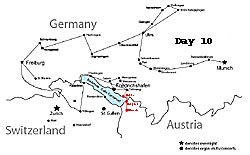 |
April 28 - May 11, 2006
Day 10 -
Lindau, Bregenz & Dornbirn
 Notes from the Road - travel log, day 10
Notes from the Road - travel log, day 10 Michael Barone’s pictures from the tour
Michael Barone’s pictures from the tour Images from Lindau
Images from Lindau Images from Bregenz
Images from Bregenz Images from Dornbirn
Images from Dornbirn Images from Haselstauden
Images from Haselstauden Day 9 - Weingarten & Weissenau
Day 9 - Weingarten & Weissenau Day 11 - Saint Gallen & Zurich
Day 11 - Saint Gallen & Zurich Main Tour Page
Main Tour Page
Lindau (Minster)
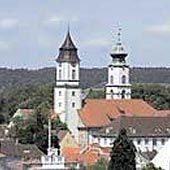 |
Located on a small island in the Lake Constance, the charming historic city of Lindau has preserved many of its middle-age buildings and many of those built after then disastrous fires of 1720 and 1728. Benedict monks built an abbey church around the year 1100. After the 1728 fire, the church was rebuilt in baroque style, with stuccos from 1746 by Franz Pozzi, and serves as RC Parish Church since 1813. The frescoes in the chancel are created by Joseph Appiani in 1750. All altars are made from stucco marble. The High altar has been made by Georg Gigl in 1753, the pulpit by Joseph Wagner from 1751.
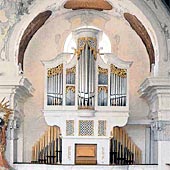 |
In 1987, the roof collapsed and caused severe damages at the organ. The organ shop Gebr. Link (Giengen) restored the organ in 1993. Today, the instrument still possesses the majority of the Steinmeyer stops from 1926-28 plus the already mentioned 18 stops from the previous 1898 Steinmeyer organ. Link, in 1993, added a few principal stops and reconstructed the two free-reed stops, Klarinette 8′ and Sanfthorn 8′ (Man. II), which had been replaced by neo-baroque stops in the 1970s.
Links and resources
 Notes from the Road - travel log, day 10
Notes from the Road - travel log, day 10 Images from Lindau
Images from Lindau Lindau - Wikipedia
Lindau - Wikipedia Find detailed organ specifications in our Tour Book
Find detailed organ specifications in our Tour Book
| Return to top |
Bregenz (RC Herz-Jesu Church)
Bregenz is the capital city of the Austrian region of Vorarlberg. The Romans called it Brigantium when they conquered the city in the 15th century and rebuilt it as a Roman city. Christianity was brought to Bregenz around the year 610 by Saint Columban and Saint Gallus. After a varied history the city was annexed by Austria in 1814.
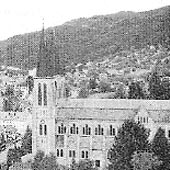 |
The ground plan shows a long nave with transept and large chancel. Most of the neo-gothique furnishings are preserved, including five altars, pulpit, baptism font and the stained glass windows in the chancel and transept (1907). The church’s interior has been restored in 1994.
Along with the organ in Dornbirn Saint Martin, this instrument is one the largest of the Vorarlberg organbuilder, Josef Behmann (Schwarzach), built in 1930-31 with 58 stops on three manuals and Pedal.
Josef Behmann was born on 22 March 1880 as the son of the organbuilder Anton Behmann in Schwarzach (Vorarlberg). As an apprentice, he entered the shop of his father in 1895. To learn more about the state-of-the-art pneumatic action, he studied with the organ builder Friedrich Weigle (Echterdingen) in 1898, before returning to is father’s shop in 1901, working as foreman in 1907 and eventually, took over his father’s shop in 1911. In the following 20 years, he employed up to 24 workers in the shop before the extinction of the firm in 1932.
Behmann preferred to equip his instruments with pneumatic cone chests, large organs had electro-pneumatic action, and he attached a great value to a refined voicing. Today, Behmann’s Bregenz organ is valued as a significant example of the Late Romantic style. The isntrument has been carefully restored in 1994 by Th. Kuhn AG (Zurich).
Links and resources
 Notes from the Road - travel log, day 10
Notes from the Road - travel log, day 10 Images from Bregenz
Images from Bregenz Bregenz - Wikipedia
Bregenz - Wikipedia Bregenz - About Austria
Bregenz - About Austria Find detailed organ specifications in our Tour Book
Find detailed organ specifications in our Tour Book
| Return to top |
Dornbirn (Parish Church)
 |
Saint Martin is the central Roman Catholic Parish Church of Dornbirn. The parish of Saint Martin is mentioned for the first time in 1130, most likely founded by the monks of Saint Gallen in the 9th century. A new Gothic church was completed in 1454 and the detached tower, crowned by a gothic spire, is preserved. After a fire caused by lightning, the church was rebuilt and enlarged in 1670. A completely new Rococo building was built in 1751-53. Some pews as well as the statues of Saint George and Saint Martin in the chancel have been preserved from this church. The corner stone of the present church was laid in 1839 and the church was consecrated in 1857. Due to the changing liturgical rites, the church’s interior was rebuilt in 1967-69; the worshippers gather around the centred altar - Christ as the center and powerful source among us.
With 72 speaking stops on three manuals and pedal, the gallery organ in Saint Martin is the largest organ in Vorarlberg and one of
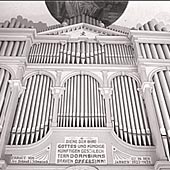 |
Links and resources
 Notes from the Road - travel log, day 10
Notes from the Road - travel log, day 10 Images from Dornbirn
Images from Dornbirn Image of Saint Martin
Image of Saint Martin Find detailed organ specifications in our Tour Book
Find detailed organ specifications in our Tour Book
| Return to top |
Dornbirn (Haselstauden)
The church, the oldest in the city, was built in 1792/93 under the supervision of master-builder Sigmund Hilbe. In 1881 Brothers of the Redemption built a cloister close to the church. After they left the cloister it was used as an orphanage and later as a school.
The main part of the church, in classic style, is topped by a steep saddleback roof. There are four round arch windows. The interior is characterized by a four-bay nave. The west end contains a curved gallery supported by two pillars with stairways on either side.
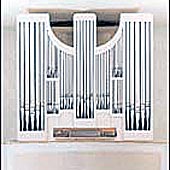 |
The church’s original request was for an instrument to accompany singing yet allow the organist to conduct the choir from the organ bench. A further requirement was that the organ complement the architecture of the room. We proposed an all mechanical instrument with 20 stops. Our concept was the most preferred even though Rieger was close by and tried hard to win the contract. The manuals are on a common wind-chest in its own case and the Pedal in a separate case behind. The console is freestanding with a space between the console and case where the choir can stand. In this way the organist can easily conduct the choir and also hear balance and registrations in an optimal way.
The specification, though modest, allows not only the accompaniment of the choir and congregation, but also provides colourful stops for the postlude or even concerts. For economic reasons we made the Rohrflöte 4′ usable in both Manuals. You can pull it either for the I Manual or the II Manual. The Sesquialtera has a pre-draw for the 2 2/3′.
The design was done by my colleague, Thomas Itten from Switzerland, who attended master class with me in Ludwigsburg. He created a very simple but well proportioned case. Since I like curved forms, he included some curves to the design to make it appear softer for the eye. The colour is eggshell white to give a light and positive appearance, and the organ looks a little bit like an angel. The case, as well as the complete interior structure, is all made of fine-grained spruce.
Links and resources
 Images from Haselstauden
Images from Haselstauden Description of organ - Glatter-Götz
Description of organ - Glatter-Götz Find detailed organ specifications in our Tour Book
Find detailed organ specifications in our Tour Book


